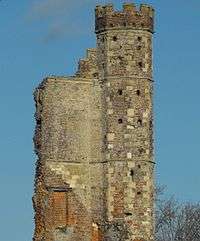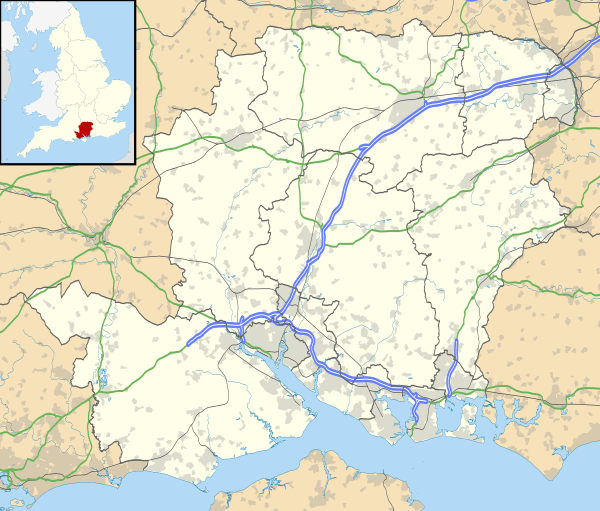Warblington Castle
Warblington Castle or Warblington manor was a moated manor near Langstone in Havant parish, Hampshire. Most of the castle was destroyed during the English Civil War, leaving only a single gate tower, part of a wall, and a gateway. The property, now in the village of Warblington, is privately owned and does not allow for public access.[1]
| Warblington Castle | |
|---|---|
| Hampshire, England | |
 Part of the remains of Warblington Castle | |
 Warblington Castle | |
| Coordinates | 50.8444°N 0.9659°W |
| Grid reference | grid reference SU729055 |
| Type | Fortified manor house |
| Site information | |
| Condition | Ruined |
Details
Located near Langstone in Hampshire,[2] the site was home to a medieval manor built in 1515 and 1525 and mostly destroyed in 1644.[3]
The Saxon settlement, established here in the 7th century, is mentioned in the Domesday Book of 1086,[4] indicating a population of about 120.[5] The owner of the property at the time was Roger earl of Shrewsbury; after his death in 1094, it was inherited by his second son, Hugh. Records indicate that the owner in 1186 was William de Courci.[6]
Some sources claim that the manor received a licence to crenellate in 1340[3] but this is disputed.[7] The manor passed through several hands before coming into the possession of Richard Neville, 16th Earl of Warwick in the 15th century.[8] Subsequently, the villagers were removed with the land becoming a private deer park for Neville.[5]
With the execution of Edward Plantagenet, 17th Earl of Warwick by Henry VII the manor was confiscated and passed to the crown.[8] In 1513 Henry VIII gave the manor to Margaret Pole, Countess of Salisbury who had a new moated manor built on the site.[8] After Margaret Pole was attainted for treason temporary grants of the manor were made to William FitzWilliam, 1st Earl of Southampton and Thomas Wriothesley, 1st Earl of Southampton.[2] Henry VIII then granted the manor to Sir Richard Cotton.[9] In October 1551, Mary of Guise the widow of James V of Scotland stayed a night in the castle as the guest of Sir Richard Cotton.[10] Edward VI visited the manor in 1552.[9] Elizabeth I may have visited for two days in 1586.[2] The Cotton family continued to hold the house until the English civil war.[9]
In January 1643 Parliamentarians under Colonel Norton garrisoned the house with a force of between 40 and 80 men.[9] It was besieged and taken by Lord Hopton although Colonel Norton managed to escape.[9][11]
The Cotton family were Royalists which resulted in the manor being largely demolished by Parliamentarian forces.[9] One turret of the gatehouse was left as an aid to navigation for ships in Langstone channel.[8] The turret is octagonal in form and four stories in height.[2] It is largely built from brick with stone dressing and battlements.[12] After The Restoration, the property was returned to the Cotton family who built a farmhouse near the ruin.[1] The latter is now Grade II listed.[13]
Today, the turret, the arch of the gate and the drawbridge support in the moat still survive.[3] The land remains private property.[14] The remains of the castle is a grade II* listed building and a scheduled Monument.[7] The Listing specifics define it as a "gateway tower, including the moulded stone arch of the gate, some of the south wall of the tower, a complete south-east octagonal stair turret, of 5 storeys, and part of the east wall (facing the courtyard)".[15]
The castle is located within the Warblington Conservation Area which also contains the adjoining Old Farm House,[16] an old cemetery, the Grade I listed St Thomas à Becket Church, Warblington[17] and the Old Rectory. [18]
As of May 2020, the owners of the castle were retired Olympic rowers Tom and Diana Bishop who reside in the seven bedroom Old Farm House on the property.[19] At that time, the property also included four acres of gardens, an orchard and a swimming pool.[16]
References
- "Warblington Castle". Lost Historic Sites. Hampshire Gardens Trust. March 2001. Retrieved 6 June 2020.
- William Page, ed. (1908). "Warblington". A History of the County of Hampshire: Volume 3. Institute of Historical Research. Retrieved 12 May 2011.
- Barron, William (1985). The Castles of Hampshire & Isle of Wight. Paul Cave Publications. p. 50. ISBN 0-86146-048-0.
- Warblington Conservation Area
- Moore, Amanda (15 August 2012). "Warblington Castle". Hampshire History. Retrieved 6 June 2020.
- WARBLINGTON Manors
- Phillip Davis. "Warblington Castle, Havant". Gatehouse Website. Retrieved 28 May 2011.
- Lloyd, David W (1974). Buildings of Portsmouth and its Environs. City of Portsmouth. p. 23.
- Godwin, G.N (1973) [First published 1904]. The Civil War in Hampshire (1642-45) and the Story of Basing House. Laurence Oxley. pp. 157–158. ISBN 0-9501347-2-4.
- Calendar State Papers Foreign Edward, London (1861), 190, (PRO SP68/9/85).
- Godwin, G.N (1973) [First published 1904]. The Civil War in Hampshire (1642-45) and the Story of Basing House. Laurence Oxley. p. 397. ISBN 0-9501347-2-4.
- Pevsner, Nikolaus; LLoyd, David (1967). The Buildings of England Hampshire and the Isle of Wight. Penguin Books. p. 641. ISBN 0140710329.
- WARBLINGTON CASTLE FAMHOUSE
- "Havant". Havant Borough Council. 10 December 2010. Archived from the original on 2011-09-28. Retrieved 11 May 2011.
- Warblington Castle
- Avis-Riordan, Katie (23 May 2018). "You can now buy this incredible castle and tower once owned by the Earl of Warwick". House Beautiful. Retrieved 6 June 2020.
- CHURCH OF ST THOMAS-A-BECKET
- https://www.havant.gov.uk/sites/default/files/documents/Warblington%20CA.pdf Warblington Conservation Area]
- [ https://www.countrylife.co.uk/property/a-17th-century-home-full-of-history-complete-with-medieval-tower-and-outdoor-pool-215431 A 17th century home full of history, complete with medieval tower and outdoor pool]